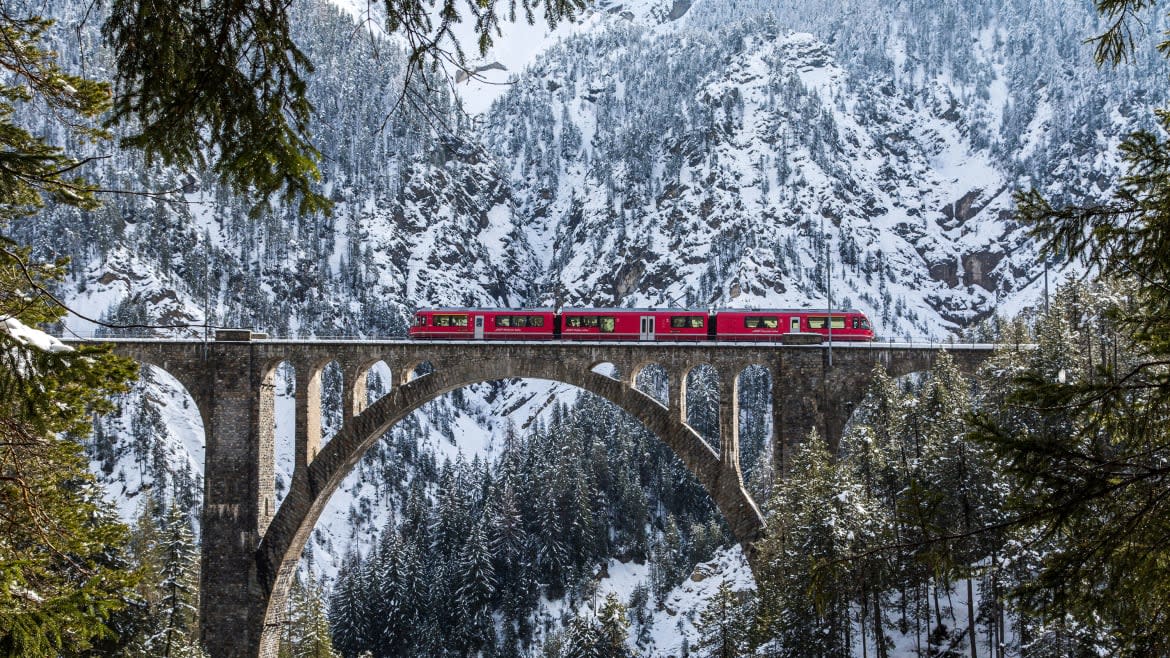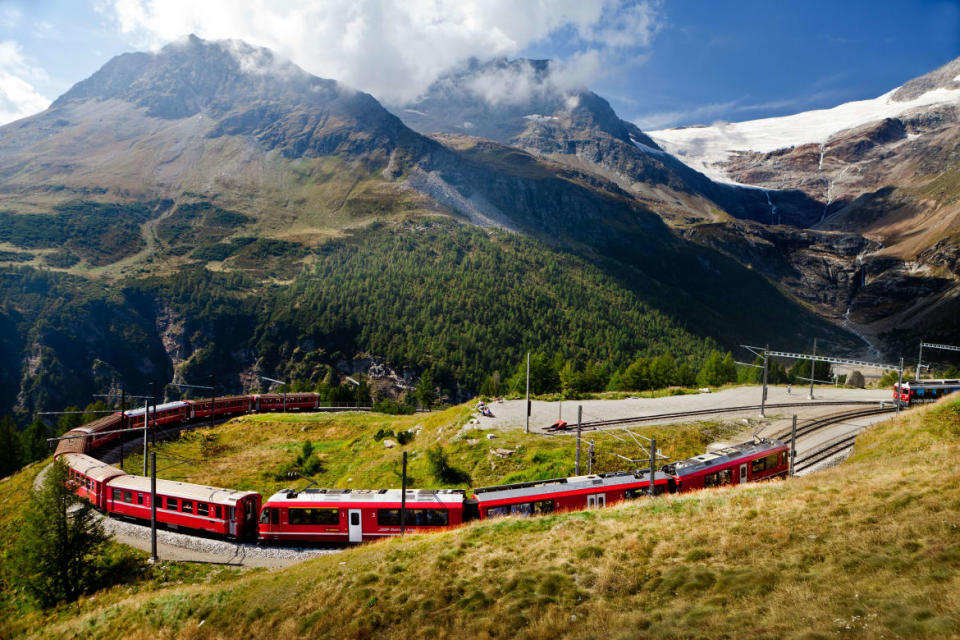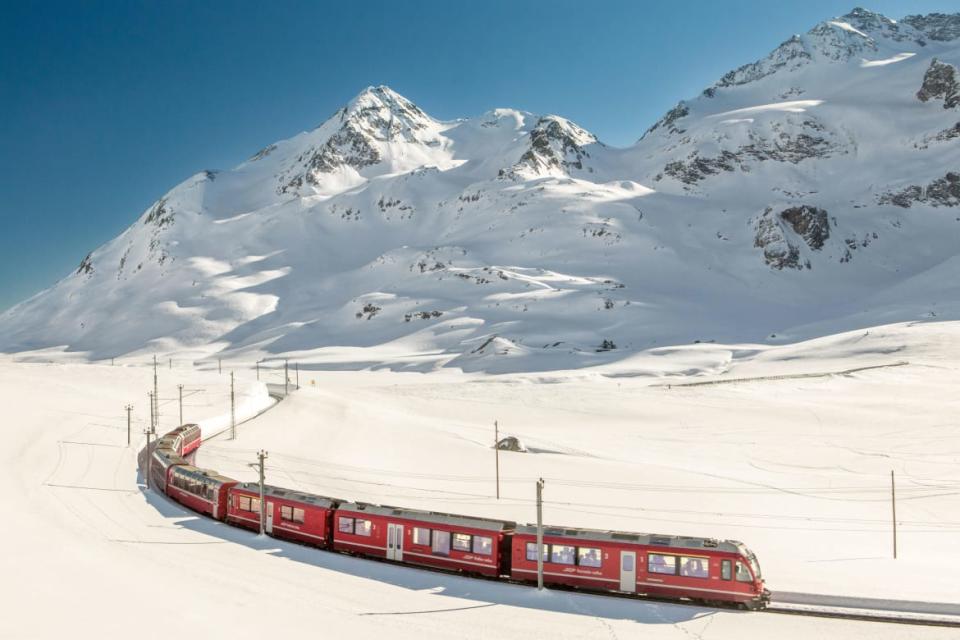Europe’s Most Scenic Train Ride Takes You Places You Didn’t Think a Train Could Go

It’s a chilly, December morning as I slink into Chur Railway Station in the southeast of Switzerland. Scanning the platforms, I eventually spot it: that trademark red exterior with the curved panoramic windows and the words Bernina Express emblazoned across the side. The other passengers have arrived and there’s a palpable excitement in the air. We are all here for one reason only—to take Europe’s most beautiful train journey.
Frequently named Europe’s most scenic train ride, the Bernina Express is a romantic throwback to the golden age of European rail travel, when the journey was the destination. In just four hours, it takes you from the town of Chur, through the tight valleys of Switzerland’s Graubünden canton, past glaciers and over the highest railway pass in Europe, into the Italian town of Tirano, where in summer you can even find palm trees.
The origins of the Bernina Express go back to the late 19th century, when enterprising hoteliers and ambitious engineers teamed up to forge a transalpine railway line, connecting the Swiss plateau to the up-and-coming resort towns of St. Moritz and Davos, and then down into the Italian region of Lombardy. It was an ambitious plan—the canton of Graubünden is incredibly mountainous and sparsely populated, even by Swiss standards. But the emergence of Alpine tourism, the debonair attitude of the era and the support of the Swiss government, which wanted access to the region’s natural resources, led to work commencing in 1898.
Envisioned primarily as a sightseeing train, the route was chosen to be as beautiful and dramatic as possible, passing glaciers, Alpine villages and crossing over the 2,253 meter Bernina Pass. To negotiate the incredible differences in height, engineers designed an intricate network of curved tunnels and radial viaducts which crisscrossed the valleys and folded in on themselves like a double helix. This was not just meant to be a daring feat of engineering but a work of art too. By the time the final track was laid in 1910, engineers had constructed 196 bridges, 55 tunnels, and connected 20 remote villages by rail for the first time. In 2008, the route was declared a UNESCO World Heritage Site.
For the first part of the journey, we follow the valley of the Rhine. We pass typical Swiss landscapes of snow-capped mountains dotted with greystone castles and pointy churches, villages of tightly huddled houses and valleys that seem to spiral into infinity. Occasionally, we are greeted by interesting facts in German and English from the onboard speaker system.
At Bonaduz, we leave the comfortable environs of the Rhine and begin our slow crawl through the narrow Domleschg valley. We cross the Solis viaduct, its looming porticoes—seemingly carved from the rock itself—carrying us over the numerous gorges that have historically made this valley so impenetrable.

It’s followed by the Landwasser viaduct, which curves elegantly on its steeply receding arches before entering the flat rock face through a tunnel, where it continues to follow the curve of the mountain. From your seat, the curve allows you to watch the train entering the tunnel, 65 meters above the valley floor—an extraordinary, vertiginous spectacle.
We stop briefly at Filisur, from where you can catch a connecting train to Davos. The Bernina Express really should be experienced twice, once in winter with snow and once in summer when the valleys revert to a lush green stillness. I’m sure autumn and spring also have their charms—this is Europe’s most scenic train ride after all.
We now enter the Albula Valley which is thinly populated with only a few disparate villages, blanketed in snow. Here the houses are not so much clustered as strewn like ribbons along the banks of the semi-frozen Albula river. The landscape is rugged and the fleeting, barn-like stations seemingly abandoned. The only living sight is a man bravely walking his black dog in the snow.
The bilingual station stop of Bergün/Bravuogn indicates that we are now crossing a border of sorts, from German-speaking to Romansch-speaking Switzerland. Graubünden is the only trilingual canton in the country, with German, Romansch and Italian all spoken, refracted into dozens of hermetic dialects within the region’s isolated, insular valleys.
Afterwards you truly begin to get a sense of what the architects had envisioned for this journey. Here, at the close of the Albula Valley, nature and engineering merge seamlessly into one miraculous organism as the railway line weaves along the contours of the mountain, through curved tunnels and helical viaducts, spiraling in on itself like a thread being pulled around a screw. The pattern is so labyrinthine that you soon lose all sense of direction, like trying to follow the logic of an MC Escher painting.
After the 5,865 meter Albula tunnel, we emerge at the Engadin valley, like moles blinking into the sunlight. Compared with the claustrophobic valleys before, the Engadin is virtually a plain, with large villages stretching heedlessly into the distance. We stop at Samedan with its postcard-pretty center contrasting with a rather merciless sprawl, much of it built in that solemn, gray cubism that is typical of Alpine modernism and which no one seems to actually like. From here, a branch of the Bernina splits off to St. Moritz, still maintaining its reputation as one of Europe’s glitziest resorts.
We arrive at Pontresina, where the train stops for a while, as if to psychologically prepare itself for what comes next. We’re especially high at this point, the trees are thinning and the peaks becoming more jagged. On our right, the onboard speaker informs me, is Piz Bernina, the highest mountain in the Eastern Alps, while below it lies the arresting sight of the Morteratsch Glacier. I stare at it in wonder. I don’t think I’ve ever seen a glacier in the flesh before.

We’ve soared past the treeline at this point. Everything is white except for our little red train choo-chooing across the tundra. Even the jagged peaks of the mountains can’t break out of their snow-covered straitjackets.
We travel along the shore of Lago Bianco, which is perfectly frozen. It’s a magnificent sight which briefly stops all the chatter on the train as people gaze motionless out the window. We stop briefly at the lakeside station of Ospizio Bernina. At 2,253 meters above sea level, this is the highest point on the Bernina Pass and the highest railway pass in Europe. We’ve also crossed the Alpine watershed, from here on we’re on the southside of the Alps, where the waters—including Lago Bianco—drain not into the Danube, but into the Po.
At Alp Grüm station, which hangs perilously close to the edge of a huge cliff, the train stops for 15 minutes to allow passengers to stretch their legs. I drop down out of the carriage, my boots stamping onto the snow below. The sky is still bright blue and only a few wispy clouds hang around, close enough to touch. It’s minus six degrees Celsius (21.2 F) according to my phone, but the cold is refreshing and pleasant. I even feel overdressed. I smile and begin to frolic. I don’t see snow like this very often and judging by the joyous reactions of the other passengers, neither do they. From the cliff-edge you can make out the verdant Poschiavo valley curling into view. Behind us, the Palü glacier trails blue. Above it rises the imposing mountain of Piz Palü, memorably referenced by Michael Fassbender’s character in Inglourious Basterds.
I get to talking with the train conductor, a young woman with strawberry blonde hair and large, round glasses that fog up every time she takes a breath under her mask.
“Is it only tourists who use this train, or do some locals take it too?” I ask.
“Mostly tourists, but some locals use it because it’s the fastest way between Chur and Poschiavo,” she replies. “In the winter, the road can be closed for days due to bad weather, but we run every day without fail. We also need to collect people from the hotel in the station.”
I look back at Alp Grüm station. Sure enough, there is a hotel emanating from its modest foundations.
“There’s a hotel in the station? A hotel? On a remote mountain top that is only accessible by a train which comes twice a day?” I splutter, with some confusion.
She shrugs. “Some people enjoy the isolation.”
At this point she goes quiet, her eyes transfixed on Piz Palü in the distance. I look at the mountain, then at her, then at the mountain again, slightly unsettled by her sudden stillness. Only the laughs of the children playing in the snow break the eerie silence.
“You know, I work this route 10 days a month,” she says, “And the landscape shifts so much between seasons. Even in the winter, the wind blows the snow around creating different patterns and ripples. I feel like I never see the same view twice.”
She blows her whistle and we all scurry back onto the train.
Now we’re descending, first the mountain tops return, then the trees. The train zigzags down the mountain leading to spellbinding views of Poschiavo and its namesake lake. We’re crossing another language border, this time into Italian-speaking Switzerland. By the time we reach the valley, the snow has vanished from ground level, leaving a lush green meadow dotted with grazing cows. In the distance, the towering, snow-drenched Bergamo Alps provide our first glimpse of Italy.
For about a minute, the train turns into tram, weaving through the tiny streets of Poschiavo, with barely a meter between you and the houses. If some idle villager were to absent-mindedly open his window at this time, it would likely smash against the train. We then ply a picturesque path along the lake, past the dinky hamlet of Miralago with great views back towards Poschiavo, then continue snaking down the valley. Phones are out and anticipation is building for the Bernina’s greatest showpiece—the Brusio spiral viaduct, which coils around itself, carrying you round then under its elegant porticoes, with the tail of the train still visible on the arches above. It’s a genuinely breathtaking moment.
The sudden proliferation of gas stations means that we’re now approaching the Italian border. We cross, imperceptible and unchecked, and head towards our destination, the Italian town of Tirano. It’s still blue skies, and the temperature is a cool 11 C (51.8 F). Again, we weave our way, tram-like, through the winding streets of Tirano. We’re in a new valley now, the Valtellina, in the Italian region of Lombardy.
Tirano is bigger than I expected it to be, but then for centuries this was one of the most important Alpine crossings and was frequently contested between rival powers. During the Thirty Years’ War (1618-1648), a dizzying array of armies fought for control here, including France, Spain, Venice, Savoy, the Papal States, the Holy Roman Empire and the local Swiss contingent known as the Grey Leagues, which gradually came out on top due to a mix of brutal fighting and skilled diplomacy. The Swiss lost the valley in 1797 to Napoleon’s Cisalpine Republic, which in turn ceded it to Austria in 1815. During the Italian Risorgimento, it was incorporated into Italy along with the rest of Lombardy in 1861.
Tirano still benefits from cross-border trade and the valley is one of the richest in Italy, famed for its cheeses and hams and home to some of the country’s snowiest ski resorts. Encircled by tall mountains, dotted with fir trees and the occasional dollop of snow, it has a solemn beauty which grows on you as you wander round, its faded old mansions hinting at a storied past. I follow the old buildings to what I presume is the central square and slink into a cryptic looking trattoria with a downbeat, mahogany interior. I order salmì di cervo, a venison stew typical of the valley, served with buckwheat polenta and casera, the local cheese. This is proper mountain food, meant for reconstituting oneself after a long day in the fields or on the slopes.
I amble my way back to the station and catch the next train to Milan. The Bernina Express may be the most beautiful train journey in Europe, but the Tirano to Milan regional train is no slouch either. The Valtellina, isolated and doused in snow, its villages clambering up the sides of the mountains, is beautiful. At the conclusion of the valley, we pass along the eastern shore of Lake Como, the sky darkening and the fog rolling ominously over the water.
After a long tunnel we emerge into the pancake flat Po Valley and the sprawling satellite towns of Milan with all their bright lights and intense rushes of urbanity. Another world really, from the glacial kingdom we’ve just departed.
For the Bernina Express timetable and reservations, visit the website.
Get our top stories in your inbox every day. Sign up now!
Daily Beast Membership: Beast Inside goes deeper on the stories that matter to you. Learn more.

